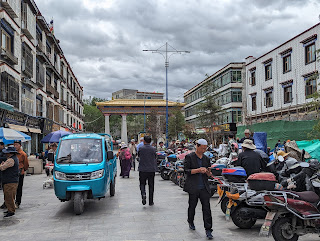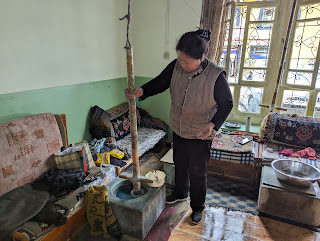
On our last morning in Lhasa, Steven and I were unaccompanied by our guide or minder and therefore had the freedom to go where we wanted. We chose to wander around the Old Town which ended up mostly following pilgrims on the Barkhor Circuit. We'd skirted Barkhor Square the previous two days but wanted to explore it in more depth and at our own pace this time. The district is considered both the spiritual heart of the Holy City and the main shopping street for Tibetans. Walking around Barkhor would be like stepping back in time as it's the one part of Lhasa that has most resisted the invasions of the modern world.
A fire truck was always parked at the edge of the square in case pilgrims or monks decided to set themselves on fire to protest Chinese policies and rules. As of May 2022, 160 monks, nuns, and ordinary people have self-immolated in Tibet since February 2009. According to the International Campaign for Tibet, "Chinese police have beaten, shot, isolated, and disappeared self-immolators who survived." According to Reuters, the Dalai Lama has said he does not encourage the protests, but he has praised the courage of those who had engaged in self-immolation and blamed the self-immolations on "cultural genocide" by the Chinese.
Just outside the security checkpoint to enter the circuit area was a woman selling huge wads of bills in small denominations so pilgrims entering Jokhang Temple could donate cash at multiple areas in the temple.
Need your teeth cleaned or have a toothache? The alley in Lhasa had about a dozen 'dental clinics' ready for your every dental need!
Since the area around Jokhang Temple has been a focus of violent political protests, the square was bordered by metal detectors at the security checkpoints, riot squad teams, and rooftop surveillance. Even though there were plenty of selfie-taking tourists, there was still an atmosphere of occupation and siege.
Steven and I followed a large throng of people, many of them pilgrims and monks, making the circuit or kora around Barkhor Square in a clockwise direction. If you click on the picture to make it bigger, you'll notice a man on the right holding a Tibetan prayer wheel used to help meditate and accumulate wisdom, and good karma, and put bad karma and negative energy aside.
The prayer wheel shop had a large collection of prayer wheels and accessories. Steven had always wanted a prayer wheel so he was happy to purchase it here as he hadn't wanted to just hit 'click' on Amazon and have one arrive the next day.
People just blithely stepped around the prostrating pilgrims.
The mani lhakhang was a small chapel with a huge prayer wheel set almost continuously in motion by pilgrims walking around it clockwise.
Next door was Nangste Shar, surely one of the most attractive former prisons and dungeons we've seen!
Its interior, however, was suitably gloomy!A few steps away was Jampa Lkakhang or Water Blessing Temple where we saw a huge two-story statue of Miwang Jampa, the Future Buddha accompanied by rows of protector gods.
Down a side alley and in a courtyard was the old Meru Nyingba Monastery which dated to the 7th century like Jokhang. For a small fee, I was able to take as many pictures as I wanted so I definitely took advantage of that.You may recall no photos were allowed in Potala Palace, Drepung Monastery, or Jokhang save one exception. I think the images here were remarkably similar to what we'd seen at the others.
I read that the monastery was invariably crowded with Tibetans thumbing prayer beads but we were pretty much alone the entire time. I don’t recall seeing more than a couple of Western tourists either our entire time on the Barkhor Circuit.
I won't soon forget the distinctive odor of yak butter that was common to all the temples in Lhasa.
Yak butter for sale so pilgrims could donate it to the temples:
Hard to imagine a more evocative place for a photo shoot.
Perdu Ambam Yamen was a museum firmly aimed at local Chinese consumption with a sign saying, "Tibet has been an inalienable part of China since ancient times..." The former residence of the Qing-dynasty Chinese ambans or political representatives contained three courtyards.
A humongous darchen or prayer pole was erected in Barkhor St. in 1681 to commemorate the great victory of a Mongolian general who was entrusted by the fifth Dalai Lama to defeat an invasion in western Tibet. Because no one could measure the length of the pole then, locals simply called it the Ganden Enormous Flag(pole).
Stylish felt hats were quite popular among Tibetan men so this shop was a great addition for their millinery options!
Notice how almost all the people in every photo were walking in the same direction, i.e. clockwise, on the Circuit.
The Shar Kyareng flagpole was one of fifteen built in 1409 to organize a prayer festival. Each was decorated to pray for the longevity of Buddha Dharma but only this one still remains.
This square used to host annual teachings by the Dalai Lama during the Monlam Festival.
Another fetching model:
Tromsikhang Market was a mostly open-air market since the original Tibetan-style building was demolished in 1997 when there was great unrest in Lhasa. Yellow yak butter was a popular item.The market area was very busy but crowd control measures were in effect.More fedoras for sale:
These men sported looks we hadn't seen before in Lhasa.
We interrupted our stroll around the Barkhor Circuit to begin walking around Lhasa's Old Town.
On one of the main streets in the Old Town, we entered another monastery but even after I looked for the name on Google Lens, I couldn't find it, unfortunately.
Monks' dormitories surrounded the courtyard.
The Assembly Hall:
Covered religious texts:
Where there's yak butter there had to be strips of yak meat!
Several shops sold beautiful, traditional Tibetan crafts but these were far too heavy to pack in my small duffle bag.
Anyone interested in monks' clothing? If so, I know just the place!
The gold building was the Karmashar Temple, once the home of the city's main oracle. We looked for the Karmashar statue and a supposedly spooky faded icon painted on a pigskin bag but saw neither.We then returned to the 2,000-strong Muslim Quarter as we hadn't had time to explore it as much as we wanted the previous day.
I think these men were caterpillar fungus traders but, please, don't ask me anything more!
The woman at the Ancient Art Restoration Center was grinding up mineral paints for thangka paintings.
In the corner of the courtyard, men, also part of the Restoration Center, were hammering away at metal sculptures and soldering a sign they were restoring for monasteries. It would have been neat to see their finished handiwork, but perhaps we already had at the monasteries we'd toured!
In the previous post, I mentioned having stopped at Dropenling, the non-profit promoting traditional Tibetan handicrafts in the face of increasing Chinese and Nepali imports.
I particularly admired the throw cushion covers and the cuddly toys but the prices made my eyes water. I bought a lovely Christmas ornament but don't know when we'll be decorating a tree with it as we'll be in Miami over Christmas this year - oh well.
I had to smile when I spotted Eric Carle's famous book, Brown Bear, Brown Bear, What Do You See? that had been translated into the Tibetan language as it's a favorite for our grandchildren!
More views of the Muslim Quarter before continuing our tour of the Circuit:
A butcher's shop:
Mini mountains of tea for sale:
Little wonder the restaurant was packed as it was one of the few we'd seen all morning.
You may also recall I had been interested in buying some material or a ready-made 'apron' that all married Tibetan women wore. No, I didn't intend to wear it over a dress but rather use it as a runner for our kitchen table as I found the striped fabrics very appealing after seeing thousands of them! Nothing like waiting until the last minute and just an hour or so before leaving for the airport but I was in luck as there were about a dozen fabric and women's clothing stores in a block or so. Our table looks so pretty with it on and it brings back such special memories of our time in Lhasa.
The distinctive yellow walls welcomed us to the Ani Sangkhung Nunnery, home to one of Lhasa's oldest shrines. We weren't able to see the shrine but the nun gave us a most beatific smile!
Close by was Lho Rigsum Lhakhang or the Temple of Three Protectors, one of four chapels surrounding Jokhang at cardinal points.
Thangka painters hard at work:
We'd hoped to complete our tour of the Barkhor Circuit with a stop at the Thangka Center but it was closed for lunch.
We weren't able (allowed?) to make our own way back to the airport and had to be accompanied by a driver and a guide. The latter was very friendly and mentioned the monument marked the first road from China to Tibet before 1959.She mentioned that the huge number of condos across the Lhasa River were all empty. Though massive numbers of Han Chinese have moved to Lhasa and the city has swollen to around 530,000 people from just 25,000 in 1950, there was room for far more people to move to Lhasa.
Tibetan Buddhist prayer flags on the mountain represent good luck. The guide said people have them on their homes and change them out every year.
Before 2007, people arriving from the airport used to have to travel two-and-a-half hours to reach Lhasa. Since the tunnels were built through the mountains, it's just an hour's journey.
The guide said the sign said, "Save the Environment."
The guide told us another sign encouraged Tibetans to "Keep Eating Barley" as it was the main crop in Tibet but young people there now prefer KFC, pizza, etc. Can't say I blame them, mind you!
The next sign said, "Work, Don't Stay Lazy!"
Lhasa River:
The guide mentioned that ninety percent of Tibetan people don't have passports. She was able to visit Nepal, however, last winter with her 14-year-old daughter which necessitated a passport. Even though her passport was valid for ten years, she had to return it to the government within eighteen days of her return to Tibet.
Tibet was certainly not the easiest region to travel to because of the difficulty in getting visas and travel permits in advance and the omnipresent Chinese security put a damper on the travel experience. But, and it's a huge but, being able to visit the Top of the World's incredible monasteries and learning about the Tibetan way of life under Chinese control was a dream come true.
On to delightful and captivating Chengdu later that night!
Next post: Going back in time with a road trip with a friend to Taos, New Mexico!
Posted on August 31st, 2024 from our home in Colorado. Wishing each of you and your loved ones good health this Labor Day weekend.



























































































































